Kitten care is important to ensure that your kitten grows into a healthy adult cat. If you have adopted a kitten or look forward to having one, you are required to learn more about kitten care. Feeding a kitten is not an easy task as he or she is going to need proper nutrition and care.

Table of Contents
What Are the Nutrient Requirements of Kittens?
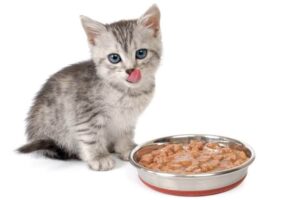
Typically, kittens are weaned off their mother’s milk when they reach 8 weeks and the owner now has to feed them. Kittens require proper nutrition as it is important to achieve healthy growth, reduce the risks of obesity, and improve the immunity of the kitten.
Kittens grow very quickly and become adult cats within no time. Their growth rates vary from one breed to another and it involves compound process interaction among nutrition, genes, and the surrounding. Proper nutrition is important regardless of the breed as it influences the body immunity and body composition of the kitten directly.
The amount of food fed and the nutrition density can differentiate between optimal and maximal growth of a kitten.
Optimal growth is a gradual and steady growth rate that lets the body of the kitten to develop fully while avoiding extra weight and obesity. Maximal growth on the other hand is a fast growth rate that is associated with free-choice feeding, overfeeding, or fatty food that results in the cat being overweight and obese.
You need to check the weight of your kitten during this feeding period and ensure that only proper nutrition is fed to the kitten for it to develop optimally.

A complete nutrient requirement for a growing kitten should include three main nutrient components, namely, proteins, calcium, and fat.
– Calcium
Kitten development formulas need to contain at least 0.8% and not exceed 1.6% calcium on a dry matter basis.
– Fat
Essential fatty acids are derived from fats. Fat is also a source of energy and it contains fat-soluble vitamins. The fat requirement for kittens should fall between 18 to 35% on a dry matter basis. This is because excess energy consumption is risky and can lead to overweight and then obesity. It can also result in orthopedic disease.
– Proteins
Proteins are important for body composition in any living organism. During the weaning stage growing kittens have a high protein demand. This demand will reduce with time when their bodies are fully developed. 35-50% dry matter basis is the recommended protein requirement for a growing kitten. 9% of this protein should come from an animal source.
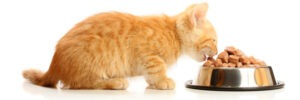
Once you select a suitable nutritional product for a growing kitten, no additional supplements whether vitamins or minerals should be fed to the kitten. Additionally, you are required to avoid those foods that produce a urinary pH of less than 6.2. Consult with your veterinary officer regarding the foods with the right pH levels to feed your kitten.
Make sure to follow all the recommendations provided by your veterinarian and the correct nutritional requirement to assist your kitten to grow into a healthy adult cat. To add to this provide your kitten with plenty of freshwaters as water is a key to keeping cats of all ages healthy.
How Much to Feed a Kitten from the Various Stage?
Kittens do a lot of growing just the human baby. Generally, a kitten will require different food ratios at each stage of its development. The type of food and how much it consumes directly affects the growth rate and body composition of your kitten.

We will look at the different amounts of food at each stage of growth.
– Newborn to 4 weeks old
The weight of a kitten at birth should fall in a range of 3 – 3.7 oz. the first few weeks a kitten will depend on the mother for food. Sometimes the mother may be ill, absent, or just rejects the kitten entirely. Under these circumstances, it is upon you as the owner to feed it. You will need to weigh the kitten to ensure that its weight reflects that of a healthy normal growth rate for a kitten.
 A newborn kitten nurses for 45 minutes every 2 to 3 hours. Those that are bottle-fed need about 15 ml of kitten feed formula at each feeding. To avoid this, you need to keep the kitten with its mother always during the first few weeks of growth. If properly fed the kitten should weigh 4 oz after one week.
A newborn kitten nurses for 45 minutes every 2 to 3 hours. Those that are bottle-fed need about 15 ml of kitten feed formula at each feeding. To avoid this, you need to keep the kitten with its mother always during the first few weeks of growth. If properly fed the kitten should weigh 4 oz after one week.
At 2 to 3 weeks a kitten still feeds every 2 to 3 hours. During each meal, the kitten should consume a half tablespoon of milk or formula. You have to continue measuring the weight of the kitten to know if it is consuming enough food. At 2 to 3 weeks the weight should have increased to about 10 oz. At this time, the kitten will start opening its eyes, crawling around, and finally standing and starting to play.
At week four the kitten will be able to walk well and play around with more vigor.
– From 4 to 6 weeks
At 4 to 5 weeks a kitten starts transitioning to solid foods. During this time, the intake of food increases. Feeding will occur less frequently and you should provide a bowl of liquid kitten food for it to start drinking from it. A kitten should be nursing three a day by the time the 5th week is ending. Additionally, it should be taking only three tablespoons of milk of kitten formula.
If correctly fed with sufficient nutritious food the kitten’s weight should be somewhere between 14 and 16 oz. At week 5 the kitten should be eating from a saucer and its food should be more of a gruel and have less water. This stage is messy since the kitten ends up walking on the food, but it is essential to start weaning it off its mother’s milk.
By the 6th week, the kitten should be consuming a gruel meal four times a day. Introduce the kitten to more dry solid food with a bowl of water at this stage. You can reduce the feeding to only three meals a day.
– From 6 to 8 weeks
At this period the kitten should be eating the dry food being provided to it three times a day. Nursing should still be allowed until the kitten reaches 2 months of age. Just like babies, some kittens will still try to nurse more than is needed. Therefore, you need to separate them from their mother from time to time. By the end of the 8th week, the kitten should weigh approximately 2 pounds. At this point, the kitten should be eating and drinking water on its own without intervention.
– From 8 to 10 weeks
When the kitten reaches eight weeks of age, the feeding time should be reduced to two meals a day of solid food. Still at this age, some will occasionally try to nurse but solid food should not be a problem for them. A kitten is fully weaned between these ages. This first vaccination of a kitten is administered when it reaches 9 weeks of age. When your kitten receives a vet visit, you can be assured of correct growth and right weight measurement.
– Feeding kitten over 10 months old
At around 10 months you can start feeding your kitten an adult’s cat food which is a combination of both dry and wet food. Kitten food has more proteins, fat, and calories than cat food. However, your veterinary doctor will advise you on how to correctly switch from kitten to cat food.
Feeding the right type of food will ensure that your kitten has a steady optimal growth. You should always check the weight and activity level of your kitten. Providing a kitten with good nutrition will result in a healthy and strong cat.
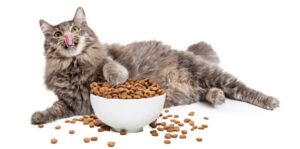
Feeding Wet Food Vs Dry Food
Food can be classified according to its water content as either dry (60%), and semi-moist(14-59%).
Wet cat food is cooked at high temperatures for efficient sterilization as a result has a longer shelf life than its counterpart. But once you open it, it is very perishable and needs to be stored correctly. Wet food is more expensive than dry food.
What Are the Benefits of Wet Food?

Feeding wet food to a cat serves as a way to provide water rather than depending on drinking water. Benefits of feeding wet foods include:
– Weight management
Wet food is majorly composed of water and water is not a source of calories. Thus wet food has lower calories than dry food which has only 14% moisture. Wet food provides calories of 0.8 to 1.5 kcal/g while dry food provides between 3 to 4 kcal/g. Wet food is therefore perfect for weight regulation or weight prevention plan.
– Constipation
Wet food prevents constipation, as it will keep the cat hydrated throughout. You are advised to feed your cat canned food if it is suffering from constipation.
- REAL MEAT, HIGH PROTEIN: Our Beef wet cat food delivers Peak Nutrition without Compromise, matching your cat's natural, whole-prey diet: featuring 92% meat, organs, and New Zealand green mussels. Our pâté-style, moisture-rich, highly palatable, chunky-loaf canned cat food delivers the nutrition and taste your cat craves.
- GRAIN-FREE, LOW CARB & LIMITED INGREDIENT DIET: Our L.I.D premium cat food recipes are made without unnecessary carbohydrates or fillers. Other brands include low quality cheap fillers such as grain, potato or peas that can be associated with sensitive stomach, obesity, food allergy, and other health concerns.
- 10% HEALTHY SUPERFOODS: Z-Boost superfood inclusions deliver an all-natural nutrition boost that helps to promote your cat’s health. Highly palatable and delicious cold-washed green tripe is a natural source of enzymes and probiotics for improved digestion. New Zealand Green Mussels contain chondroitin, glucosamine, and omega-3 for joint health and enhanced skin and coat. Organic Kelp is a natural source of minerals and antioxidants known to improve metabolism, reduce inflammation and protect the heart and brain.
- ALL LIFE STAGES & ALL BREEDS: Formulated for kitten, adult, and senior cats – ZIWI’s holistic approach is for all life stages, focused on delivering peak nutrition for your cat’s health and wellbeing. Perfectly fed as a complete meal or topper for a nutritional boost; optimized for both indoor and outdoor cats.
- ETHICAL NEW ZEALAND INGREDIENTS: 100% free-range, grass-fed meats, cage-free poultry, and wild-caught seafoods, all sourced from New Zealand farms and pristine oceans. Raised without added hormones, antibiotics, or growth promotants, these all-natural ingredients provide a taste of life in New Zealand.
– Urinary health
Concentrated urine is harmful to your cat since it will result in a high concentration of inflammatory substances in the urinary bladder of the cat. Wet food is essential as it promotes more dilute urine. This will reduce urinary tract problems.
What Are the Benefits of Dry Food?
 The main advantage of dry food is its convenience, ease, and cost. Many cats are fed dry food and live a long healthy life. With dry food, you can free feed and leave the food out without any worries of it deteriorating.
The main advantage of dry food is its convenience, ease, and cost. Many cats are fed dry food and live a long healthy life. With dry food, you can free feed and leave the food out without any worries of it deteriorating.
Some of the dry foods have a valuable dental effect on the health of cats, either reducing tartar formation or slowing plaque accumulation.
Dry foods also have high calories compared to wet foods. They can provide energy and necessary nutrients in small concentrated volumes.
How Much Wet Food or Dry Food to Feed a Kitten?

The amount of food to give your cat is determined by many factors. The weight of your cat will guide you on its calorie needs. You should be feeding your cat based on its ideal weight, not its actual weight. An overweight and small-boned cat will need fewer amounts of calories compared to another cat with the same pounds but with large bones and more muscles. The latter will need more calories to maintain its weight.
Age and activity also play a vital role in determining the amount of food to give your cat. A growing kitten needs a lot of energy than an adult cat. A very active cat that is always playing and running will require more calories compared to a cat that is always sitting. Also, a lactating mother needs extra calories to keep producing milk and remain healthy simultaneously.
How Often to Feed a Kitten?
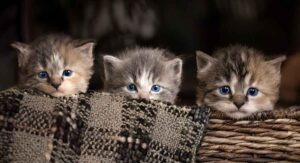
Kittens are fed depending on their age. A newborn kitten needs feeding every 2 to 3 hours every day for about 45 minutes. Feeding reduces gradually to about 4 to six times a day. During its feeding always check the weight at different ages to ensure that they are getting all the food they require. The number of times a kitten is fed keeps reducing with the age.
When the kitten has passed 8 weeks of age feeding should be reduced to twice a day while also incorporating normal kitten food. A kitten may nurse from time to time but solid food should not be a problem.
How Do Kittens’ Nutritional Needs Differ from Those of Adult Cats?
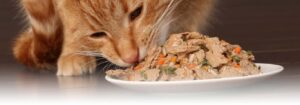
During the first weeks of a kitten’s life, its weight may double or triple alternatively. The kitten is very active during its development stage and to match their activity levels they need more calories than adult cats. Hence, kittens need to eat more than four meals a day to get the energy they require for their rapid growth and match their level of activeness.
Jenifer Larsen, a nutritional consultant at the Veterinary Medical Teaching Hospital at the University of California indicates that kittens’ requirements for fatty acids and vitamins are the same as those for adult cats. However, their needs for proteins, minerals, and vitamins are higher compared to adult cats.
How Can I Know I’m Selecting High-quality Kitten Food?
 To be sure that you are selecting a superior kitten food, firstly look at the label. It should state that it meets the nutritional needs of kittens established by AAFCO (American Association of Feed Control Officials). Additionally, it should state that it is complete and balanced nutrition for the growth of kittens. This statement shows that your kitten will not need any vitamin or mineral supplements.
To be sure that you are selecting a superior kitten food, firstly look at the label. It should state that it meets the nutritional needs of kittens established by AAFCO (American Association of Feed Control Officials). Additionally, it should state that it is complete and balanced nutrition for the growth of kittens. This statement shows that your kitten will not need any vitamin or mineral supplements.
Supplements are used only when recommended by your veterinary doctor after a vet visit. You should always be very careful with homemade diets as they can be low in essential nutrients such as calcium. This can lead to a mineral imbalance resulting in a disease that is common among cats referred to as hyperparathyroidism.
When your kitten is properly fed it will be healthy, clean, have a steady weight gain, and very much alert.
When to Switch to Adult Cat Food?
When your cat reaches 10 months it is time for you to switch from kitten food to adult food. At this age, their body composition is fully developed and they no longer need the extra calories and nutrients found in kitten formula. The transition from kitten formula to adult formula should be gradual and not a one time transfer. You need to transition for at least four days to avoid intestinal distresses.
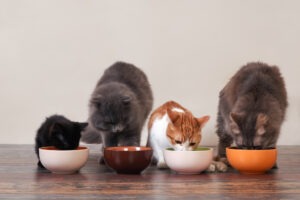 On the first day, you can include 75% of kitten formula with 25% adult food. On the second day, mix an equal ratio of both the foods. On the third day, increase adult food to 75% while reducing the kitten food to 25%. Finally, on the last day, switch to 100% adult formula.
On the first day, you can include 75% of kitten formula with 25% adult food. On the second day, mix an equal ratio of both the foods. On the third day, increase adult food to 75% while reducing the kitten food to 25%. Finally, on the last day, switch to 100% adult formula.
At this stage, free-choice feeding will be most effective as cats eat what they want. With this technique, you provide your cat food and let it eat at any time it wants. Caution should however be taken since some cats may overeat. To solve this problem the food can be proportioned and given to the cat at regular intervals twice per day.
Furthermore, constantly check your cat’s weight and body during the shift. If you realize that your cat is gaining or losing weight when it should not, you can alter their consumption and weigh them again after a week.
What Foods Should Cats Avoid?
We may want to treat our cats with different types of foods but some pose health risks. Some of the foods you should not feed your cat are:
– Milk and dairy products
You have grown knowing that cats need or love cow’s milk and dairy products. The truth of the matter is that cow’s milk and cats do not mix. Cats are lactose intolerant in nature and consumption of dairy products may distress their stomachs causing diarrhea and vomiting. For kittens that need milk apart from that is not their mother’s milk, veterinarians recommend specific milk formulas that provide the necessary nutrients.
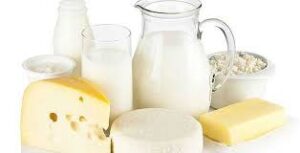
– Raw eggs, meat, and fish
Raw foods contain bacteria such as Salmonella and E.Coli, which can cause diarrhea and vomiting. Salmonella can also cause a reduction in the absorption of vitamin B leading to skin and coat problems, loss of appetite, seizures. These pathogens can even be fatal.
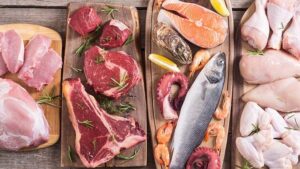
– Dog food
If you also have a dog in your home, your cat might have at one time consumed the dog’s food. This food will not harm the cat but continuous consumption will cause malnutrition. Cats need taurine, arachidonic acid, and vitamin A, all of which are absent in dog food.
– Garlic and onions
Garlic and onions cause anemia in cats. These products whether raw or cooked can damage red blood cells, cause nausea, abdominal pains, diarrhea, and vomiting.
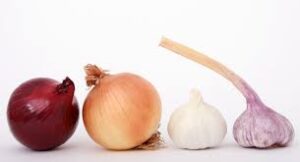
Frequently Asked Questions:
1. Can you overfeed a kitten?
It is completely impossible to overfeed a kitten from a few weeks up to 4 months as their growing body is always demanding nutrients. At a young age, the kitten is constantly moving around, jumping from one point to another. The only time they stop is when they are hungry and need food to provide them the energy they need to play around.
2. Should I let my kitten eat as much as it wants?
Yes, yes, yes. You definitely should let your kitten eat as much as it wants. Unlike adult cats, kittens need much more calories and will not become overweight when they eat more. Besides, kittens are very active animals, thus will need more calories. Just ensure that you are providing it with nutrient-dense food that will provide all the essential nutrients it requires for growth at the different growth rates. Apart from food, ensure that your kitten has a regular supply of freshwater.
3. Why does my kitten act like it is starving?
Kittens are very vigorous animals. Because of this high amount of energy and the fact that most of them double their weights every week during their development face, they will appear to be hungry all the time. The calories are burnt at a fast rate just as they are consumed. Your kitten should never go hungry and constantly feed him. Your kitten will eventually develop quickly into a strong, fully-grown adult cat. You should not be worried about this unending appetite as with time it will disappear when the kitten is fully-grown.
4. Do kittens stop eating when they are full?
A kitten will stop eating when they are full just like every other living creature. You should bear in mind that kittens love playing and jumping around very much. Thus, they require a lot of calories which become quickly depleted when they play. Depending on their age, they will require food after every 2 to3 hours.
5. How do I know if my kitten is overeating?
Your kitten needs a lot of food to grow in the first weeks. However, too much food will pose a threat to your kitten. The basic indication that your kitten is overfeeding is diarrhea. Diarrhea is an indication that your kitten is overfeeding and you need to adjust how you feed it. A healthy kitten poop is yellow and firm but an overfeeding kitten poop will vary in color, green is medium and grey is critical. When the poop changes color book an appointment with the vet.
6. How many times a day should I feed my kitten?
The recommended number of times you need to feed your kitten a day is three times. That is in the morning, afternoon, and evening. Having this feeding plan allows you to control the kitten’s nutrition easily. It also allows you to ensure that your kitten does not overeat which might be fatal if the diarrhea is critical. Additionally, it helps ensure that your kitten grows at a gradual rate and does not become overweight and successively obese.
7. Should I leave dry food out for my kitten overnight?
Leaving the food out overnight for hours may ruin and contaminate it. Besides, other animals might end up eating your cat’s food. Just put the dry food in the bowl or sauce and do not leave it out overnight. This will ensure that the cat gets to free feed when it wants but does not have to consume contaminated food, as this will pose a health risk to it.
Alternatively, dry food can be left out overnight for free feeding as it does not coagulate and spoil easily.
8. Should cats have food available at all times?
Kittens need food throughout since they are still in the growth phase. These kittens will need meals for at least three meals a day to meet their nutritional requirements. Growing cats at about six weeks to maturity will need feeding at least twice a day since their calorie requirements are decreasing. A mature cat needs food once or twice per day and should be maintained at that throughout its lifetime.
Conclusion
We have seen that a kitten requires more calories than an adult cat. When providing the necessary calories ensure that you are also serving it the essential nutrients it requires, proteins, fat, and calcium. With this article whether you were planning to adopt a kitten or you have an expectant mother cat, we believe that you can fully provide and cater for your kittens.

